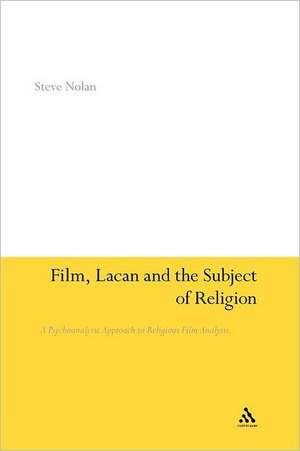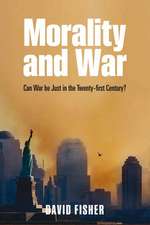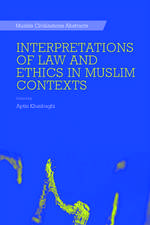Film, Lacan and the Subject of Religion: A Psychoanalytic Approach to Religious Film Analysis
Autor Revd Dr Steve Nolanen Limba Engleză Paperback – 19 oct 2011
In
their
study
of
religion
and
film,
religious
film
analysts
have
tended
to
privilege
religion.
Uniquely,
this
study
treats
the
two
disciplines
as
genuine
equals,
by
regarding
both
liturgy
and
film
as
representational
media.
Steve
Nolan
argues
that,
in
each
case,
subjects
identify
with
a
represented
'other'
which
joins
them
into
a
narrative
where
they
become
participants
in
an
ideological
'reality'.
Finding many current approaches to religious film analysis lacking,Film, Lacan and the Subject of Religionexplores the film theory other writers ignore, particularly that mix of psychoanalysis, Marxism and semiotics - often termedScreentheory - that attempts to understand how cinematic representation shapes spectator identity. Using translations and commentary on Lacan not originally available toScreentheorists, Nolan returns to Lacan's contribution to psychoanalytic film theory and offers a sustained application to religious practice, examining several 'priest films' and real-life case study to expose the way liturgical representation shapes religious identity.Film, Lacan and the Subject of Religionproposes an interpretive strategy by which religious film analysts can develop the kind of analysis that engages with and critiques both cultural and religious practice.
Finding many current approaches to religious film analysis lacking,Film, Lacan and the Subject of Religionexplores the film theory other writers ignore, particularly that mix of psychoanalysis, Marxism and semiotics - often termedScreentheory - that attempts to understand how cinematic representation shapes spectator identity. Using translations and commentary on Lacan not originally available toScreentheorists, Nolan returns to Lacan's contribution to psychoanalytic film theory and offers a sustained application to religious practice, examining several 'priest films' and real-life case study to expose the way liturgical representation shapes religious identity.Film, Lacan and the Subject of Religionproposes an interpretive strategy by which religious film analysts can develop the kind of analysis that engages with and critiques both cultural and religious practice.
| Toate formatele și edițiile | Preț | Express |
|---|---|---|
| Paperback (1) | 256.85 lei 6-8 săpt. | |
| Bloomsbury Publishing – 19 oct 2011 | 256.85 lei 6-8 săpt. | |
| Hardback (1) | 889.88 lei 6-8 săpt. | |
| Bloomsbury Publishing – 22 iul 2009 | 889.88 lei 6-8 săpt. |
Preț: 256.85 lei
Nou
Puncte Express: 385
Preț estimativ în valută:
49.15€ • 51.32$ • 40.58£
49.15€ • 51.32$ • 40.58£
Carte tipărită la comandă
Livrare economică 15-29 aprilie
Preluare comenzi: 021 569.72.76
Specificații
ISBN-13: 9781441133151
ISBN-10: 1441133151
Pagini: 232
Dimensiuni: 156 x 234 x 12 mm
Greutate: 0.33 kg
Editura: Bloomsbury Publishing
Colecția Continuum
Locul publicării:London, United Kingdom
ISBN-10: 1441133151
Pagini: 232
Dimensiuni: 156 x 234 x 12 mm
Greutate: 0.33 kg
Editura: Bloomsbury Publishing
Colecția Continuum
Locul publicării:London, United Kingdom
Caracteristici
Looks
at
current
approaches
to
religious
film
criticism,
offering
a
new
framework
by
which
religion/theology
can
engage
more
effectively
with
contemporary
film.
Notă biografică
Dr
Steve
Nolan
is
an
experienced
film
critic
and
author
of
many
journal
articles.
He
holds
a
PhD
from
the
University
of
Manchester
and
works
at
The
Princess
Alice
Hospice
in
Surrey,
UK.
Cuprins
Introduction
An Overview
Part 1 Current approaches to religious film analysis
1 Phenomenological interpretations: film as sacrament
2 Literary interpretations: film as visual story
3 Anthropological interpretations: film as religion
Part 2 Representation in liturgy and film
4 Liturgical representation: 'others', narratives and ideological 'realities'
5 Cinematic representation: 'others', narratives and ideological 'realities'
Part 3 What can film theory offer liturgy?
6 Cinematic identification: suture and narrative space
7 Suturing suture: joining the theory together
8 Suturing religious identity in the sacramental narrative
By way of analysis
An Overview
Part 1 Current approaches to religious film analysis
1 Phenomenological interpretations: film as sacrament
2 Literary interpretations: film as visual story
3 Anthropological interpretations: film as religion
Part 2 Representation in liturgy and film
4 Liturgical representation: 'others', narratives and ideological 'realities'
5 Cinematic representation: 'others', narratives and ideological 'realities'
Part 3 What can film theory offer liturgy?
6 Cinematic identification: suture and narrative space
7 Suturing suture: joining the theory together
8 Suturing religious identity in the sacramental narrative
By way of analysis
Recenzii
"In
this
engrossing
and
provocative
study,
Steve
Nolan
explores
the
insights
which
film
theory
has
to
offer
to
the
study
of
religion
and
film.
Rather
than
focusing
on
theological
meanings
or
religious
narratives
within
the
film,
Nolan
argues
that
it
is
in
the
effects
on
the
spectator
that
we
discover
the
analogy
between
liturgy
and
cinema.
Engaging
closely
with
the
theoretical
perspectives
of
the
journal
Screen
and
with
Lacanian
psychoanalysis,
Nolan
opens
up
exciting
new
possibilities
for
approaching
the
liturgy
as
a
form
of
participative
representation,
analogous
to
film,
and
the
implications
of
this
for
the
construction
of
religious
identities,
the
transmission
of
religious
ideology,
and
the
role
of
the
priest
in
the
liturgical
performance."
-
Professor
Tina
Beattie,
Roehampton
University,
UK
"Steve Nolan's book is a genuinely creative advance in the study of religion and film, establishing a new sense of their relationship through an understanding of film as liturgical experience, and thus suggesting a highly original answer to the question, "What can film theory offer liturgy?" It is a challenging read in its powerful theoretical grounding of the experience of cinema in Lacanian theory of dreams, but the rewards are considerable in the series of brilliant readings of the role of priests in individual films from Bing Crosby's Father Chuck O'Malley in the 1945 The Bells of St. Mary's to Jeremy Irons in The Mission and Henry Fonda in The Fugitive. This book takes the study of film and religion onto a new level of critical and theological sophistication, challenging alike to film theory and to theology and liturgical studies." - Professor David Jasper, University of Glasgow, UK
"This is an original and thought-provoking book. Nolan provides an intelligent, nuanced and critical invitation to consider what the insights of Lacanian pyschoanalysis, 'Screen film theory' and liturgical participation can contribute to the study of both film and religion. Hollywood hits, such as Air Force One, and more controversial productions, such as The Siege, are put to creative use to illustrate his sophisticated argument. Drawing on a wide range of other films and theorists, Film, Lacan and the Subject of Religion is a significant and stretching contribution to the rapidly evolving area of study related to film, religion and theology." - Dr Jolyon Mitchell, University of Edinburgh, UK
"Steve Nolan's book is a genuinely creative advance in the study of religion and film, establishing a new sense of their relationship through an understanding of film as liturgical experience, and thus suggesting a highly original answer to the question, "What can film theory offer liturgy?" It is a challenging read in its powerful theoretical grounding of the experience of cinema in Lacanian theory of dreams, but the rewards are considerable in the series of brilliant readings of the role of priests in individual films from Bing Crosby's Father Chuck O'Malley in the 1945 The Bells of St. Mary's to Jeremy Irons in The Mission and Henry Fonda in The Fugitive. This book takes the study of film and religion onto a new level of critical and theological sophistication, challenging alike to film theory and to theology and liturgical studies." - Professor David Jasper, University of Glasgow, UK
"This is an original and thought-provoking book. Nolan provides an intelligent, nuanced and critical invitation to consider what the insights of Lacanian pyschoanalysis, 'Screen film theory' and liturgical participation can contribute to the study of both film and religion. Hollywood hits, such as Air Force One, and more controversial productions, such as The Siege, are put to creative use to illustrate his sophisticated argument. Drawing on a wide range of other films and theorists, Film, Lacan and the Subject of Religion is a significant and stretching contribution to the rapidly evolving area of study related to film, religion and theology." - Dr Jolyon Mitchell, University of Edinburgh, UK

















